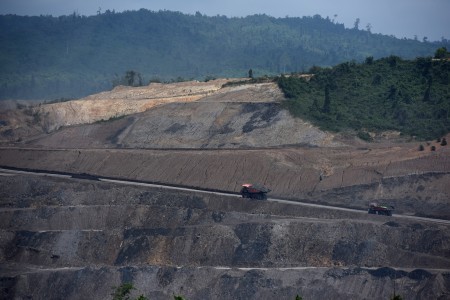Indonesian coal miners remain cautious despite predicted increase in demand
Change Size
 Trucks carrying heavy equipment pass through the site of a coal mining field in East Kalimantan on Aug. 19. (Antara/Wahyu Putro A)
Trucks carrying heavy equipment pass through the site of a coal mining field in East Kalimantan on Aug. 19. (Antara/Wahyu Putro A)
D
espite rising coal prices and new research indicating that the country’s coal production will begin to increase, coal miners are still doubtful the rise in demand is enough to significantly boost domestic production in the near future.
BMI Research, a unit of Fitch Group, has predicted that Indonesia—which is among the five largest thermal coal producing countries— will see its coal production increase by an average 7.5 percent per year from 2017 to 2020, after suffering from a 15 percent year-on-year (yoy) decline this year.
“This will ensure the country increases its global market share from 4.2 percent in 2016 to 5.4 percent in 2020. Indonesia’s additional output will be used to meet strong demand from a domestic pipeline of coal-fired power plants,” said the report, which was published on Friday.
The government is currently implementing an electrification program aimed to add 35,000 megawatts (MW) in power generation capacity across the country by 2019. Almost 20,000 MW under the program will come from coal-fired plants.
Publicly listed Bumi Resources will remain the largest coal miner in Indonesia, according to the report.
“Through its two coal subsidiaries, Kaltim Prima Coal and Arutmin Indonesia, the company produced 60.0 million tons of coal in the first nine months of 2015, down 7.7 percent yoy,” it said.
The report also said that India and Russia were set to increase their market shares in thermal coal production as well, with only Russia’s additional output destined for the seaborne market.
Other large producers, including China and the US, will slowly lose market share.
Although the report paints a pretty picture, the Indonesian Coal Mining Association (APBI) casts some doubt on any significant increase in production for the next couple of years.
APBI deputy director Hendra Sinadia said the electrification project was not enough to spur production for domestic coal miners, because many power plants would not begin operations until 2019.
“I doubt there will be any significant increase from 2017 to 2018, because most of the power plant projects need two to four years before the commercial operation date,” he told The Jakarta Post.
According to data from the association, coal demand for electrification stands at around 80 million tons per year and has the potential to double by the time the government’s electrification program is completed.
However, progress in the 35,000 MW project has been slow, and by September, data from state-owned electricity company PLN show, that less than 1 percent of the total 35,000 MW has gone into commercial operation since the program was launched in late 2014.
The APBI acknowledges that there has been a sudden increase in coal prices after the coal market was badly hit for the past two years.
Reuters reported that the Asian benchmark Newcastle thermal coal price reached US$105.81 per metric ton at the end of last month, almost 109 percent higher than at the end of last year.
Meanwhile, Indonesia’s coal reference price (HBA) for November rose to $84.89 per metric ton, up from $54.43 per metric ton at the same time last year.
However, the trauma of low prices might be enough to discourage mining companies from boosting production too much, Hendra said.
“The volatility of coal prices has made companies more cautious. They are now more psychologically hesitant, which leads to more conservative production plans despite high prices,” he said, adding that companies that had shut down some of their mines due to low coal prices would need several months before the mines could start operating again.
Government data reveal that Indonesia had around 32.2 billion tons of coal reserves in 2014.
However, another study conducted by the APBI and auditing firm PricewaterhouseCoopers suggests that low prices make only 7.3 to 8.3 billion tons of coal economically viable to mine.
These reserves will most likely be depleted within the next two decades, forcing the country to start importing coal by 2030.









